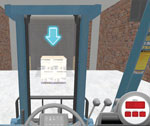Virtual Task Forks
Operating industrial lift trucks is no game. Training to operate them can be.
 |
NSC Safetyworks™ Lift Truck puts trainees in the virtual driver's seat. |
Every year in the United States, nearly 100 workers are killed in forklift-related incidents and, according to OSHA, "tens of thousands" more are injured. Truck tipovers are the leading cause of the fatalities, followed by workers being crushed between a vehicle and a surface. After conducting investigations of the incidents, the National Institute for Occupational Safety and Health reported that many workers and employers simply may not be aware of the risks involved with operating or working near forklifts and/or are not following the procedures set forth in OSHA standards, consensus standards, or equipment manufacturers' guidelines, which is another way of saying that too many people have somehow failed to grasp that these vehicles are dangerous.
More or better education on the hazards associated with lift trucks is clearly needed. The National Safety Council (which at its Web site seriously downplays the annual forklift-related toll, estimating only 11 deaths and 9,500 injuries per year) has, like many other organizations, long offered standard lift truck safety training kits, books, and on-site-seminar services. But last year, deciding to take its offerings a step further, the council partnered with Etcetera Edutainment of Pittsburgh and lent both its name and seal of approval to a videogame-based training product called NSC Safetyworks™ Lift Truck.
Welcome to Grid World
Introduced in September at NSC's annual Congress and Expo, the 3D simulator program is designed to enhance, not replace, lift truck safety training by allowing operator trainees to drive in a virtual "grid world," a multi-facility warehouse environment, guided by a series of task-based practice lessons based on regulations OSHA promulgated in 29 CFR 1910.178, from truck inspection and maintenance to actual operation. Using controls on a standard keyboard to manipulate the truck and forks, fasten a seatbelt, apply a handbrake, sound a horn, or get a rear view, operators are required to execute everyday exercises with increasing levels of difficulty—stacking, unstacking, and restacking crates, stabilizing loads, transporting them up and down ramps going forward and in reverse—while responding to common obstacles and conditions and receiving feedback in real time. An off-the-shelf steering wheel can be purchased separately to create a more realistic driving experience. After taking a final exam, qualified game operators receive an NSC certificate reflecting completion of the training.
"Our game traverses quite a bit of real estate and touches on a lot of the safety rules that pertain to safe driving," said Deborah Shearman, Etcetera's vice president of product marketing. "It does give a simulation of the driving, although that's not exactly what we're training. . . . What we're providing is a way to practice safety with a forklift and have those lessons be 'stickier,' or more retainable."
Unlike the passive and only "semi-sticky" activities of PowerPoint slide viewing and video watching that passes for training at most companies, the Safetyworks simulation forces responses, decision making, and dynamic interaction from trainees who, increasingly, are primed for such learning, Shearman said. "The workplace is to some degree changing, and it's driven in part by a younger group of workers coming in to the market who are accustomed to taking in information in ways different than people who might be older," she noted. "It's not cut and dry, but there are differences in the degree to which people engage--and differences in attention span, to be blunt. So this training meets well with the kind of animation that younger people often expect because of their conditioning with video games."
Test Drive
Part of the appeal of simulator training is its capacity for allowing trainees to make whatever mistakes they might make in the virtual world—taking a corner too fast, tipping a truck, running through a warehouse wall or headlong into a pedestrian--without repercussions in the actual world. "That's actually one of the selling points: It's real-world scenarios in a risk-free environment," Shearman said. "They can maneuver through the grid world environment without damaging property or exposing themselves or others to danger."
When trainees do violate an OSHA regulation, on-screen pop-up messages instantly alert them of the transgression, which Shearman said is part of the value of immersive training. "It's sort of like having someone sitting by you, looking over your shoulder, and saying, 'Hey, remember this? Hey, remember that?' which is not something you get easily and certainly not something you get when you're sitting in a classroom with a bunch of other people drinking coffee and watching a video."
To download a free demo of the program, visit www.nsc.org/osh/products/safetyworks.aspx or www.etceteraedutainment.com/nsltdemo/.
This article originally appeared in the May 2009 issue of Occupational Health & Safety.